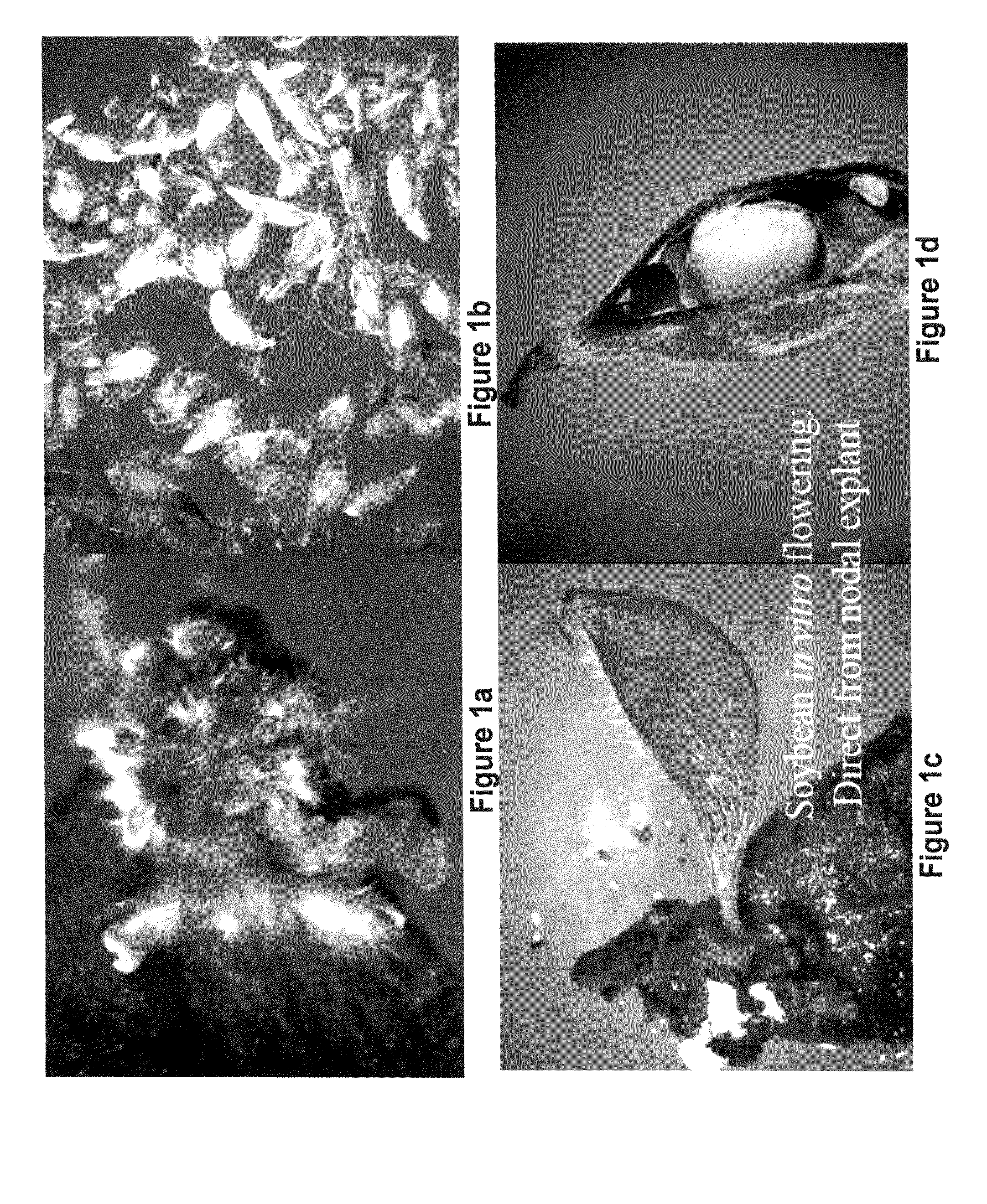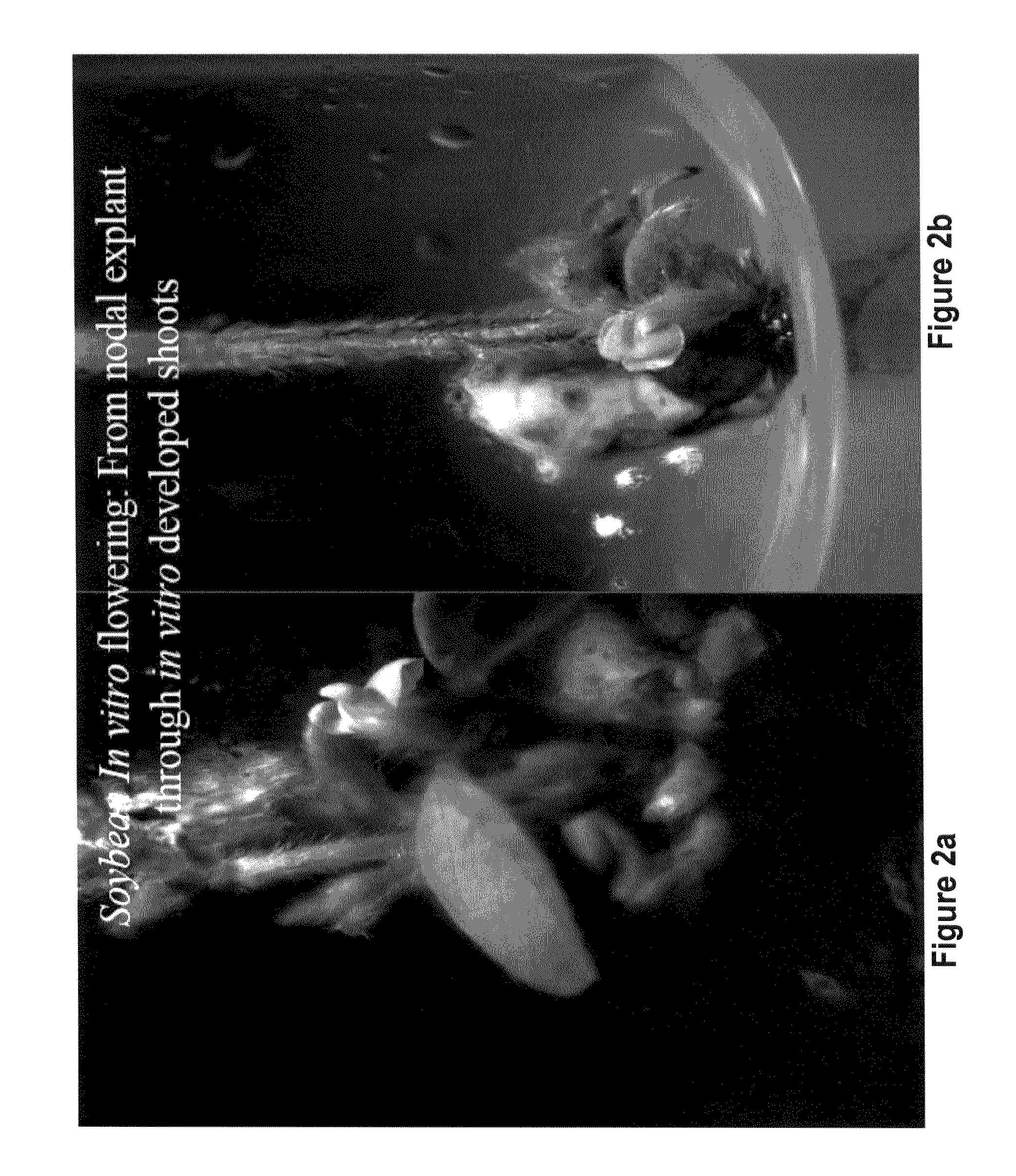Method for producing direct in vitro flowering and viable seed from cotyledon, radicle, and leaf explants, and plants produced therefrom
a technology of radicles and leaves, which is applied in the field of producing direct in vitro flowering and viable seeds from cotyledon, radicles, leaf explants, and plants produced therefrom, and can solve the problems of genetic base, posing a significant new threat to the soybean industry both, and the risk of national crop germplasm
- Summary
- Abstract
- Description
- Claims
- Application Information
AI Technical Summary
Benefits of technology
Problems solved by technology
Method used
Image
Examples
example 1
Direct Fertile Flower Bud and Viable-Seed Production on Cotyledon
[0133]Healthy soybean seeds are hand picked and washed with a few drops of soap (Linquinox, Fischer scientific, Pittsburgh, Pa.) for 10 minutes in running tap water. The seeds are then sterilized in 70% ethyl alcohol for 1 min and treated with 0.1% (w / v) mercuric chloride for 10 min. Sterilized seeds are again washed for three times at five minute intervals with sterilized distilled water, and plated six seed on each petri plate containing 20 ml of MSB5 medium. Three-day-old aseptic seedlings are used as the source material for explant preparation. Six isolated cotyledons are plated on each culture plate in such a way that the abaxial side in contact with the medium. MSB5 medium supplemented with different concentrations of TDZ (0.1, 0.5, 1.0, 2.0 and 5.0 mg / L) either alone, or in combination, with BAP (1.0-4.0 mg / L) are tested for flower induction. The media is augmented with 3% (w / v) sucrose and solidified with 0.56%...
example 2
Fertile Flower Bud and Viable Seed Production from In Vitro Developed Shoots from Cotyledons
[0135]Healthy soybean seeds are hand picked and washed with a few drops of soap (Linquinox, Fischer scientific, Pittsburgh, Pa.) for 10 minutes in running tap water. The seeds are then sterilized with 70% ethyl alcohol for 1 min followed by a ten minute treatment with 0.1% (w / v) mercuric chloride. Sterilized seeds are again washed for three times at five minute intervals with sterilized distilled water, and plated 6 seed on each petri plate containing 20 ml of MSB5 medium. Three-day-old aseptic seedlings are used as the source material for explant preparation. Six isolated cotyledons are plated on each culture plate in such a way that the abaxial side in contact with the medium. MSB5 medium supplemented with different concentrations of TDZ (0.1, 0.5, 1.0, 2.0 and 5.0 mg / L) either alone, or in combination with, BAP (1.0-4.0 mg / L) are tested for flower induction. The media is augmented with 3% ...
example 3
Direct Fertile Flower Bud and Viable-Seed Production from Radicle Explants
[0137]Healthy soybean seeds are handpicked and washed in running tap water with few drops of soap (Linquinox, Fischer scientific, Pittsburgh, Pa.) for 10 minutes. The seeds are then surface sterilized with 70% alcohol for one min followed by 0.1% (w / v) mercuric chloride for 10 min. After the treatment, seeds are washed thoroughly for 3 times at 5-minute intervals with sterilized distilled water. Sterilized seeds (6 per plate) are transferred to culture plates (100×150 mm) containing 20 ml of modified MSB5 vitamins solidified with 0.56% agar (Phytotech Labs) for germination. The pH of the media is adjusted to 5.8 with 0.1 M NaOH or 0.1 M HCl before autoclaving at 1.4 kg cm−2 for 20 min at 121° C. The seeds are incubated in dark at 25±2° C. for 3 days.
[0138]After 3 days of seed germination, the seed coat is carefully removed with a sterile forceps, and cotyledons are detached from the seedling using surgical bla...
PUM
| Property | Measurement | Unit |
|---|---|---|
| concentration | aaaaa | aaaaa |
| concentration | aaaaa | aaaaa |
| concentration | aaaaa | aaaaa |
Abstract
Description
Claims
Application Information
 Login to View More
Login to View More - R&D
- Intellectual Property
- Life Sciences
- Materials
- Tech Scout
- Unparalleled Data Quality
- Higher Quality Content
- 60% Fewer Hallucinations
Browse by: Latest US Patents, China's latest patents, Technical Efficacy Thesaurus, Application Domain, Technology Topic, Popular Technical Reports.
© 2025 PatSnap. All rights reserved.Legal|Privacy policy|Modern Slavery Act Transparency Statement|Sitemap|About US| Contact US: help@patsnap.com



